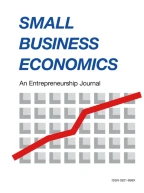
Given that recent research on entrepreneurial behavior and success has established skill variety as a central human capital factor, researchers, educators, and policymakers have turned their interest to a deeper understanding of the formation of skill variety. Based on human capital theory and the competence growth approach in developmental psychology (highlighting long-term, age-appropriate, and cumulative skill-growth processes), we hypothesize that a broad, early variety orientation in adolescence is a developmental precursor of such entrepreneurial human capital in adulthood. This was confirmed in an analysis of prospective longitudinal data via structural equation modeling and serial mediation tests. We also find that an entrepreneurial constellation of personality traits, but not entrepreneurial parents, predicts early variety orientation, skill variety, and entrepreneurial intentions. By shedding new light on the long-term formation of entrepreneurial human capital, the results suggest that establishing and benefiting from an early variety orientation is not only an important developmental mechanism in entrepreneurial careers but gives those with an entrepreneurial personality an early head start in their vocational entrepreneurial development. Implications for future research and practice are discussed.
Human capital is important for entrepreneurship. In particular, a varied skill set enables entrepreneurs to tackle the various tasks of starting a new firm. However, no one is born with such a skill set; it develops over time. In this study, we explore the origins of a varied skill set and its development. We find that skill variety in adulthood has its roots in a varied set of interests among teenagers, such as having many hobbies or finding different school subjects important. This growth in skill variety is driven by an entrepreneurial personality. For prospective entrepreneurs, our research suggests that investing in a varied skill set pays off. The implication for research is to look at the developmental process of how people become entrepreneurs. The most important conclusion for policymakers and educators is that educational support programs should center around encouraging especially adolescents and young adults to engage in varied activities and teach varied skills instead of focusing on a narrow curriculum.
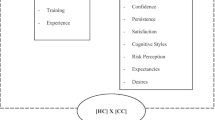
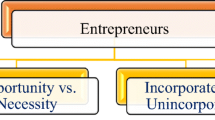
Avoid common mistakes on your manuscript.
Why do some people become entrepreneurs while others stay in paid employment? What predicts entrepreneurial success? A great deal of research investigating these fundamental questions has focused on human capital (Canavati et al., 2021; Davidsson & Gordon, 2012; Unger et al., 2011). According to Becker (1964), human capital is composed of knowledge and skills that are acquired through schooling, on-the-job training, and other kinds of experience. The most important development in this research field has been Lazear’s (2005) skill variety model. Searching for a distinctive set of entrepreneurial skills and abilities that matches the profile of the entrepreneurial task, Lazear (2005) introduced a theoretical model focusing on a varied skill set in entrepreneurs. He argues that because entrepreneurs perform many different tasks, they should be multi-skilled in various areas, for example, developing a business model, talking to customers, working in a team, and negotiating with suppliers. A wide range of papers (see Krieger et al., 2018 for a literature review) have found empirical support for the hypothesis that individuals with a varied skill set are more likely to become entrepreneurs than those with a specialized skill set (Chen & Thompson, 2016; Hsieh et al., 2017; Lazear, 2005; Silva, 2007; Wagner, 2006; Xiao et al., 2020). In addition, skill variety often has positive performance effects (Aldén et al., 2017; Åstebro & Thompson, 2011; Patel & Ganzach, 2019; Rosendahl Huber et al., 2020).
However, while empirical research has delivered such relatively consistent and striking evidence for the important effects of skill variety on entrepreneurial outcomes, we know astonishingly little about the determinants of such skill variety (Krieger et al., 2018). This is a crucial research question since it can inform not only research on human capital formation but also the fields of entrepreneurship education and policy, which are debating potential mechanisms on how to build entrepreneurial human capital in various populations.
In economic research, two schools of thought have emerged to explain the process of the accumulation of skill variety: the investment and the endowment view. On the one hand, proponents of the investment view argue that individuals purposely invest in skill variety by, for example, switching jobs and working in different fields (Lazear, 2005). On the other hand, proponents of the endowment view question the intentionality of skills acquisition. In particular, Åstebro and Thompson (2011) and Silva (2007) argue that the process of skill acquisition and, ultimately, the decision to become an entrepreneur is driven by stable personal characteristics such as “taste for variety” or “entrepreneurial talent.” While Åstebro and Thompson (2011), as well as Silva (2007), find empirical evidence for the endowment view, Stuetzer et al. (2013b) find empirical evidence for both the investment and the endowment view. One caveat of the existing studies investigating the origins of skill variety is their empirical focus on the time period after the respondents entered the labor market.
To the best of our knowledge, there are only a few papers investigating relevant sources of skill variety by focusing on insights from developmental psychology and targeting earlier developmental periods. One such important foundational period is clearly adolescence (Lerner & Damon, 2012; Obschonka, 2016; Schoon & Duckworth, 2012)—a period which is, according to developmental psychologists, pivotal to accumulating work-related skills and forming vocational interests (e.g., Hartung et al., 2005). Obschonka et al. (2017) already examined skill variety in adolescence and its effects on entrepreneurial alertness and intentions (Obschonka et al., 2017), but this study did not examine skill variety in adulthood—the central construct in the present study. Given the scarcity of research insights addressing the growth and formation of entrepreneurial human capital, particularly from a skill variety perspective and under consideration of a developmental approach, this paper aims to make a contribution regarding the formation of skill variety across adolescence and adulthood. We focus on two research questions: (1) Do early developmental precursors of skill variety exist in adolescence? (2) What are the determinants of these early precursors and thus subsequent skill variety in adulthood?
To tackle both research questions, we investigate whether a variety of early interests and activities in adolescence predicts subsequent variety in skills and knowledge that builds the basis for an intentional entrepreneurial career. How do we define variety of early interests and activities in adolescence? Here, we understand it as an early variety orientation, where the variety of early interests and activities is a very broad concept encompassing different hobbies and interests in different school subjects. In contrast, subsequent variety in skills and knowledge in adulthood is a rather narrow concept purely related to entrepreneurship. Hence, we study broader, age-appropriate early variety as a precursor of more concrete, age-appropriate skill variety in adulthood, which follows the logic of age-appropriate and cumulative skill growth over the lifespan (Cunha & Heckman, 2007; Heckman, 2006; Masten et al., 2010). We also investigate underlying determinants of this age-appropriate, cumulative growth process underlying skill variety. In particular, we focus on potential determinants, which can inform the endowment and investment views in the economic literature by testing person and context effects. Figure 1 summarizes our conceptual model, which assumes that both person and context effects are relevant drivers in age-appropriate, cumulative growth processes leading to skill variety in adulthood via their important early variety orientation in adolescence.
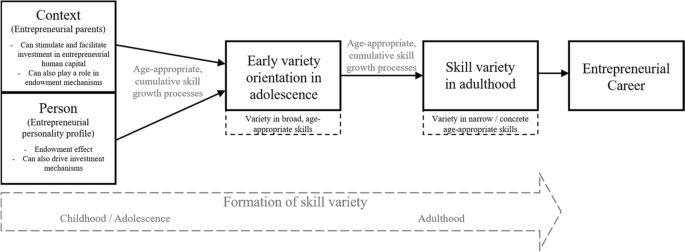
Answering the two research questions raised above is important because there is a controversy in the field of entrepreneurship education over whether entrepreneurship can be taught or whether entrepreneurs are born (Åstebro & Hoos, 2021; Kuratko, 2005). Numerous entrepreneurship education programs have been created in the past decades in schools and universities (Brüne & Lutz, 2020; Kuratko, 2005). Some of these programs have been evaluated in terms of randomized controlled trials, but the empirical evidence casts doubt on the effectiveness of such programs (Åstebro & Hoos, 2021; Elert et al., 2015; Fairlie et al., 2015; Oosterbeck et al., 2008; Peterman & Kennedy, 2003). Our study testing early precursors of skill variety and underlying determinants can shed some light on which skills could be targeted in entrepreneurship education programs and what role the developmental period (e.g., adolescence vs. adulthood) plays in human capital formation. We clearly need better knowledge about the process of how entrepreneurial human capital grows and cumulates, and why many entrepreneurs appear to benefit from an early head start in their entrepreneurial development (Obschonka et al., 2010, 2011; Schmitt-Rodermund, 2004).
The remainder of the paper is organized as follows. In Sect. 2, we develop the hypotheses. In Sect. 3, we describe the data and the methods used. In Sect. 4, we present the empirical results, which are discussed in Sect. 5. Section 6 concludes the paper.
Searching for the “essence” of entrepreneurial human capital, Lazear (2005) developed a widely acknowledged model of vocational choice. The author highlights the importance of skill variety for entrepreneurs. In that regard, we see skill variety as having a varied set of skills and knowledge due to working in different functions, having a varied curriculum at school or university, and switching employers (Chen & Thompson, 2016). This skill variety pays off in entrepreneurship because entrepreneurs have to perform many different tasks (Lechmann & Schnabel, 2014), such as developing a business model, hiring first employees, negotiating with customers, and acquiring financial capital, to name a few. In contrast, skill variety does not pay off in most paid employment occupations because the tasks that have to be conducted in these occupations are more specialized (Lazear, 2005). Given the advantages of skill variety for the entrepreneurial task, people with a varied skill set are more likely to become entrepreneurs compared to people with no or less skill variety (Åstebro & Thompson, 2011; Chen & Thompson, 2016; Lazear, 2005; Silva, 2007; Wagner, 2006). Skill variety also positively affects the progress of nascent venture projects toward a fully fledged firm (Stuetzer et al., 2013a) and longevity of the business among entrepreneurs (Oberschachtsiek, 2012).
Entrepreneurial behavior is often argued to be intentional because people invest a considerable amount of time and money in it. It is something people plan or choose to do (Obschonka et al., 2010). In this regard, entrepreneurial intentions are understood as “states of mind that direct attention, experience and action toward a business concept” (Bird, 1988, p. 442). In other words, there is a certain readiness to engage in entrepreneurship (Goethner et al., 2012). Empirical studies have shown that entrepreneurial intentions are a strong predictor of entrepreneurial action (Krueger, 2009; Lee et al., 2011). We argue that because skill variety is very advantageous for entrepreneurship, people with skill variety are aware of the fit between their skill set and the entrepreneurial task. Accordingly, this readiness in skills should foster the development of entrepreneurial intentions. Empirical support for this reasoning comes from Backes-Gellner and Moog (2013), who show that a broad human capital portfolio positively predicts the disposition to become an entrepreneur.
Taken together, if skill variety in adulthood is indeed that conducive for entrepreneurship as proposed by Lazear (2005) and indicated by a growing number of studies (e.g., Åstebro & Thompson, 2011; Chen & Thompson, 2016; Stuetzer et al., 2013b), such skill variety should also predict entrepreneurial intentions. Taken together, our baseline hypothesis H1 states:
Connecting the insights from developmental psychology with the formation of human capital, we follow the argumentation of Jayawarna et al. (2015), who highlight the importance of human capital accumulation in the early stages in life for the formation of human capital in later stages. Human capital acquired in early stages bolsters the development of human capital in later stages in a synergistic way. Cunha and Heckman (2007) describe human capital acquisition as a hierarchical process where “the skills produced at one stage augment the skills attained at later stages” (p. 35). In a similar vein, developmental psychologists argue that the growth in competencies is cumulative—starting in childhood and impacting skills across the life span (e.g., Jordan et al., 2009; see also Obschonka, 2016).
As we are interested in the development of skill variety conducive to entrepreneurship, we extend the models of skill acquisition from focusing on a single skill toward a variety of skills. We argue that adolescents with a variety of early interests and activities (henceforth—early variety orientation) are more likely to acquire more skill variety in later stages. This early variety orientation includes but is not limited to interest in different school subjects, participating in a range of non-curricular activities at school, and having different hobbies. While engaging in a variety of activities, adolescents acquire a variety of early skills. Applying the developmental psychology models of competence growth to skill variety, this variety of early skills lays the foundation of future skill variety. This claim is based on learning theories, which argue that acquiring knowledge and improving skills is greatly enhanced by interest and prior knowledge (Hartley, 1998; Tobias, 1994).
Surprisingly, not much research in developmental psychology and economics has been done on this topic. One of the few exceptions is Munson and Savickas (1998), who discovered a positive relationship between broad leisure activities and career exploitation behavior among students in the USA. Further supporting arguments can be found in the literature on giftedness. Milgram and Hong (1999) examined highly gifted adolescents in Israel. They found that those with an undifferentiated skill set (variety) had less differentiated vocational interests. Put differently, individuals with skills concentrated within certain domains had more specific career interests. Following competence growth models (Cunha & Heckman, 2007; Heckman, 2006; Masten et al., 2010), our hypothesis basically assumes that a variety in broad, age-appropriate interests and activities in adolescence fuels the formation of such age-appropriate, narrow, and concrete skill variety in adulthood.
If early skill-growth processes are indeed fundamental for the formation of entrepreneurial human capital, one needs to better understand the underlying determinants of such early skill-growth processes. What context or person factors contribute to this early precursor and thus to the growth of human capital essential for entrepreneurial behavior and success? One potential determinant of such an early variety orientation is the context factor of entrepreneurial parents. Entrepreneurial parents have been highlighted as role models during the early formative years (childhood and adolescence) in various studies (Bosma et al., 2012a; Chlosta et al., 2012; Falck et al., 2012; Obschonka et al., 2011). It has been argued that entrepreneurial parents can influence entrepreneurial activities of their children via the transfer of knowledge and skills, as well as via other paths such as social capital and financial capital (see for a review Bosma et al., 2012a; Schmitt-Rodermund, 2004). Footnote 1 This suggests that individuals with entrepreneurial parents have stronger entrepreneurial intentions. In the following, we theorize about the influence of entrepreneurial parents on the development of entrepreneurial human capital and entrepreneurial intentions.
We draw on social learning theory (Bandura, 1986), which explains individual learning by the observation of parental actions and transferring these into one’s mental models. These mental models determine the offspring’s decisions (Bandura, 1986; Bandura & Walters, 1963; Rosenthal & Bandura, 1978; Rotter et al., 1972), such as the choice of early interests and activities or later occupational choice (Scherer et al., 1989; Schulenberg et al., 1984). As children of entrepreneurs observe that their parents are engaged in very different activities in their firm, they might start to engage in a variety of activities—although arguably at a lower level of intensity and in age-appropriate activities and hobbies (cf. Obschonka et al., 2011). It might also be the case that entrepreneurial parents encourage their offspring to try out different hobbies or activities and thus generate an early variety orientation. In a similar vein, Chlosta et al. (2012) argue that the children of entrepreneurs are introduced to business methods, develop entrepreneurial values (e.g., striving for independence), and obtain a realistic job preview through their entrepreneurial parents at an early age.
Later on, entrepreneurial parents might more directly influence the acquisition of skill variety by giving their offspring the possibility to work in their firm. By doing so, they can engage in the different tasks in a firm, such as talking to customers, production, or bookkeeping. The direct exposure to these different tasks should foster the acquisition of a varied skill set (Gibson, 2004; Parker, 2009; Stuetzer et al., 2013b).
As highlighted in Fig. 1, such an effect of the parental context can be seen to reflect investment mechanisms. However, it cannot be ruled out that this also partly covers endowment effects in a way that the context effect is driven by genetic effects (Nicolaou & Shane, 2009; Rutter, 2006; Scarr & McCartney, 1983). Here, we assume that children of entrepreneurs develop a stronger tendency to engage in an intentional entrepreneurial career than children without such parents because they develop more skill variety from early on. This leads to the following hypotheses:
Besides an early stimulating context, research suggests that basic personality characteristics such as the Big Five personality traits may also drive entrepreneurial human capital growth (Obschonka, 2016; Schmitt-Rodermund, 2004). The five-factor model, which is the predominating personality traits model in contemporary psychological science, refers to five fundamental human traits: neuroticism (anxious and depressive), conscientiousness (hard working and persisting), agreeableness (cooperative and altruistic), extraversion (cheerful and seeks excitement), and openness (receptivity to new experiences). These Big Five traits have a substantial genetic base and are relatively stable over time (Costa & McCrae, 1992; Roberts et al., 2006). Hence, we can assume that they drive human capital growth and not the other way around.
The Big Five traits have been frequently studied in entrepreneurship research (Brandstätter, 2011), including developmental studies suggesting that they indeed drive entrepreneurial competence growth from childhood and adolescence onwards (Obschonka et al., 2011; Schmitt-Rodermund, 2004, 2007). These studies found that an entrepreneurial personality profile (intra-individual constellation of the Big Five traits with higher scores in extraversion, conscientiousness, and openness, and lower scores in neuroticism and agreeableness) drive entrepreneurial competence growth when focusing on single competences. Here, we extend this view by focusing on the variety of competences, following Lazear’s (2005) human capital approach. Such an entrepreneurial personality structure might signal a certain entrepreneurial propensity in a person (e.g., Obschonka & Stuetzer, 2017), making the entrepreneurial development of a person more likely, including relevant human capital growth. There should be many entrepreneurs without such an entrepreneurial constellation in their personality structure, but, on average, this personality structure makes entrepreneurial development more likely (Obschonka & Stuetzer, 2017).
The idea that an entrepreneurial constellation of personality traits (rather than single traits) is important for entrepreneurship is not new. Several other notable researchers argue that such a constellation of traits is an indication of endowed entrepreneurial talent (Knight, 1921; Lucas, 1978; Rosti & Chelli, 2005; Schumpeter, 1934; Silva, 2007) which has the potential to affect the development of human capital, entrepreneurial thinking, and activity over the life span. Specifically, Stuetzer et al. (2013b) and Silva (2007) suggest that entrepreneurial talent drives the growth in skill variety because the talent gets expressed via concrete interests, activities, and competences. As stressed in Fig. 1, this would reflect the endowment perspective in economic research, although one cannot rule out certain investment mechanisms as, for example, young individuals with a stronger entrepreneurial personality may therefore invest more in their entrepreneurial human capital as an expression of, and guided by, their personality profile.
We propose the following hypotheses:
Figure 2 summarizes our hypotheses on (1) the growth of skill variety with early variety orientation in adolescence as the central developmental precursor, (2) the driving role of an early stimulating context (entrepreneurial parents), and (3) the driving role of an entrepreneurial personality profile.
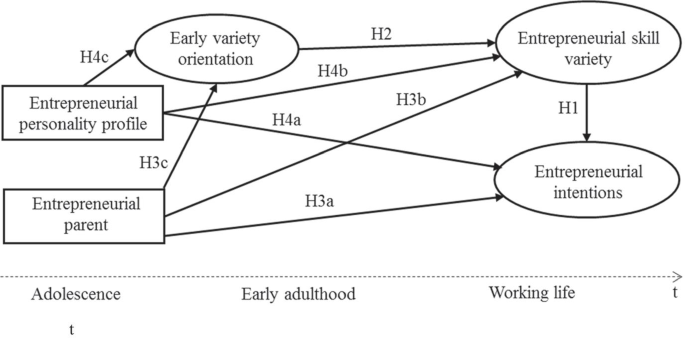
Prospective longitudinal data covering both the early developmental phase (adolescence) and an adult phase (working life) is particularly suitable to answer research questions on skill growth over time (Masten et al., 2010). Other studies investigating early entrepreneurial competencies and skill variety have often collected data on adolescents retrospectively (e.g., Obschonka et al., 2010, 2011; Schmitt-Rodermund, 2004), which comes at the risk of measurement errors due to memory decay and hindsight bias (Davidsson, 2006). Footnote 2 Here, we thus utilize the Finnish FinEdu study—a longitudinal prospective cohort study. The study was launched in 2004 and was conducted in several waves over a span of 10 + years. At the first wave of data collection (T1) in 2004 of this collaborative project, run by the University of Helsinki and the University of Jyväskylä, the participants were, on average, 16 years old. We use the first seven waves of data, with the seventh wave in 2013 (T7), where the average age was 26 years; 39.3% of the participants (N = 342) were male and 60.7% (N = 529) were female.
The general aim of the FinEdu study is to examine changes in well-being, personal goals, and motivation of adolescents as a consequence of the transition into upper secondary school and work life, respectively. The study considers the social environment of adolescents (school, parents, peers, hobbies) (Salmela-Aro, 2015). In the last wave of the study, several entrepreneurship items were added (e.g., entrepreneurial intentions, skill variety).
The study was designed to follow students of two different school tracks (A and B). Students of school track A (N = 455) attended lower secondary school, whereas school track B (N = 418) attended the academic track of upper secondary school (Tuominen-Soini et al., 2011). In our analysis, we combined the data of the two school tracks controlling for school track effects (see also Tuominen-Soini & Salmela-Aro, 2014; Ranta et al., 2013). The combination of the two school tracks is possible because we do not expect that the mechanisms regarding the development of skill variety differ between both school types.
Note that in the first wave of data collection at age 16, we have data from 1,321 respondents. In the T7 wave at age 26, 941 respondents participated. This means that 29% of the first-wave respondents were lost to attrition. The main reason for attrition was that at the last wave, respondents had left school at some point during the FinEdu project and their contact details could not be determined or they rejected participation. Of the 941 respondents in the last wave, 68 did not answer the skill variety and entrepreneurship items. We excluded those respondents with missing information from the analysis, leaving us with a sample of 873 respondents. Although the attrition rate is comparatively low compared to other longitudinal studies (e.g., Obschonka et al., 2012; Schoon, 2001), we discuss the issue of attrition and the consequences for our empirical strategy in more detail in the “Results” section.
Table 1 provides an overview of the variables, including means, SDs, Cronbach’s alphas, and sample items. Additional information on the variables is provided below.
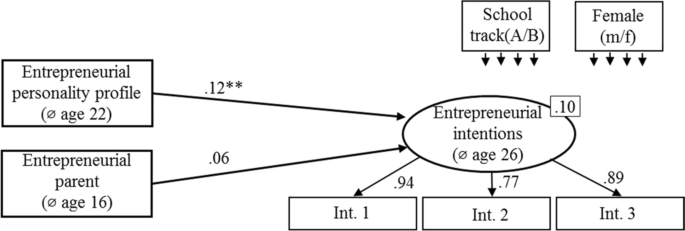
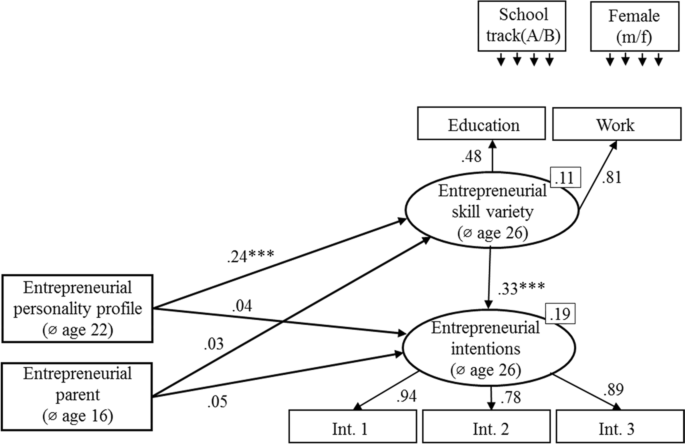
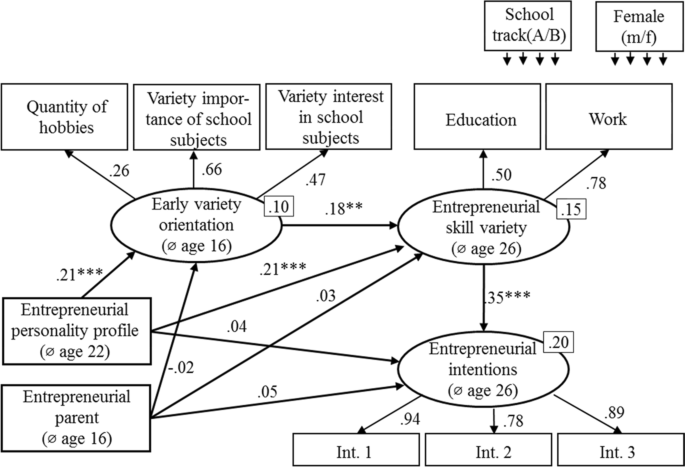
This pattern of effects suggests that the effect of an entrepreneurial personality profile on entrepreneurial intentions is (partly) mediated via early variety orientation and skill variety. The results of the respective test for this proposed serial mediation are summarized in Table 3. Within our main model, we calculated the serial mediation effect of an entrepreneurial personality over early variety orientation and skill variety on intentions using bootstrapping with 2000 replications. The SEM model is the same as in Fig. 5, but the coefficients of the relationship between entrepreneurial personality and skill variety are not used to calculate the indirect effect. In other words, the indirect effect refers only to the path between entrepreneurial personality over early variety orientation and subsequently over skill variety on intentions. The standardized indirect effect of entrepreneurial personality on entrepreneurial intentions was β = 0.013 (p < 0.05). The unstandardized bootstrapped effect was 0.003, with 90% CIs of 0.001 to 0.007. Thus, the indirect effect was statistically significant. In total, 10.73% of the direct effects of an entrepreneurial personality profile on entrepreneurial intentions are explained by this path.
The aim of this paper was to examine the making of skill variety. Based on human capital theory and developmental psychology, we theorized on the formation of skill variety. We focused on two research questions. First, do early precursors of skill variety exist in adolescence? According to our empirical results, the answer is yes. An early variety orientation in adolescence (age 16) precedes subsequent variety in skills and knowledge at age 26. This skill variety then subsequently predicts entrepreneurial intentions. This finding is in line with the major approach in developmental psychology and economics that the development of skills is a long-term cumulative process (Cunha & Heckman, 2007; Heckman, 2006; Holland & Nichols, 1964; Obschonka & Silbereisen, 2012).
This finding can also inform entrepreneurship education programs on two points. On the one hand, entrepreneurship training might emphasize teaching a variety of skills or, given the young age of the participants, of engaging participants in a variety of activities. On the other hand, entrepreneurship education programs might be more successful when focusing on adolescents. According to Åstebro (2016), one lesson that can be learned from the evaluation studies on entrepreneurship education programs is that programs targeting younger age groups, such as the BIZ World Program (Huber et al., 2014) and Junior Achievement Program (Elert et al., 2015; Peterman & Kennedy, 2003), seem to have a stronger impact than programs focusing on students such as the GATE program (Fairlie et al., 2015) and a French program to foster social entrepreneurship among students (Åstebro & Hoos, 2021). Our study only measures early variety orientation at one particular point in time (age 16) and not for different points in time. However, the fact that there is a connection between early variety orientation at age 16 and subsequent skill variety supports our reasoning.
The second research question was on the determinants of these early precursors and subsequent skill variety. We found that early variety orientation was predicted by an entrepreneurial personality profile. We also found that skill variety (at age 26) was predicted by an entrepreneurial personality profile. This supports the endowment view in skill acquisition and concurs with developmental research on the effect of personality traits on the formation of entrepreneurial competencies (Obschonka & Silbereisen, 2012). The positive and significant relationship between the entrepreneurial constellation of the Big Five traits and early variety orientation further supports the importance of the person-oriented perspective in developmental psychology, which argues that personal dispositions are often at the start of developmental processes. The findings also concur with the taste for variety approach, which basically makes the same argument that individuals who turn out to become entrepreneurs are often driven by an innate ability to strive (Åstebro & Thompson, 2011). The positive and significant relationship between an entrepreneurial personality profile and early variety orientation as well as subsequent skill variety is in line with empirical findings of Silva (2007), Stuetzer et al. (2013b), and Obschonka (2016) who argues that innate dispositions also shape the skill-accumulation process. Mediation tests confirm the relevance of the serial-mediation path from an entrepreneurial personality via early variety orientation, skill variety, and subsequently entrepreneurial intentions.
From these results, additional implications arise for entrepreneurship education programs. One reason for the rather weak effects of entrepreneurship education programs could be that the effectiveness of these programs might depend on the participants’ personality traits and innate abilities. One could argue that such programs might be more effective for a participant with high innate abilities and personality traits that are conducive to entrepreneurial action. Empirical support for this kind of differentiated effect comes from Schröder and Schmitt-Rodermund (2006), who show that the effectiveness of an entrepreneurship education program conducted at the age of 16 in German schools was strongest among participants with an entrepreneurial personality profile (measured the exact same way as in this study). On the other hand, for students with a less entrepreneurial personality profile, programs may need to be designed in more intensive formats (e.g., longer programs and more intensive learning sessions facilitating skill formation that is less naturally stimulated by endowment processes).
We did not find any significant effect of entrepreneurial parents on early variety orientation, skill variety, and entrepreneurial intentions, which is surprising because there is strong empirical evidence by other studies on the importance of role models for entrepreneurial intentions (e.g., Bosma et al., 2012a). This finding speaks against the context dimension in our framework and the investment view in skill acquisition. There are two possible explanations for the non-finding. First, we empirically tested whether having, at the age of 16, entrepreneurial parents matters for the formation of variety, but it might be that entrepreneurial parents matter more at a later age when adolescents take over more responsible jobs in their parent’s firms. We could not test this conjecture with our data because parents’ occupation was only assessed in T1 (at age 16) and not in subsequent waves.
Second, our variable entrepreneurial parents might not capture parental role models in the Finnish context well. According to the 2011 data from the Global Entrepreneurship Monitor (Bosma et al., 2012b), Finland has a below-average percentage of the adult population engaged in entrepreneurial activity (Finnish TEA rate = 6.3%, average TEA rate across innovation-driven economies = 6.9%). However, Finland ranks well above average in the percentage of people involved in intrapreneurial activity (EEA) (Finnish EEA rate = 8.0%, average EEA rate across innovation-driven economies = 4.6). In this context, intrapreneurship refers to launching a new product, setting up a new business unit or subsidiary for an employer as part of a person’s normal work—all tasks that are comparable to setting up a new firm as an entrepreneur. These tasks also require a somewhat varied skill set. Thus, it might be possible that intrapreneurs can also serve as parental role models, which in our approach are coded not to be role models. We thus tested whether entrepreneurial + intrapreneurial parents predict the formation of early variety orientation, skill variety, and entrepreneurial intentions. To this end, we computed a dummy taking the value of 1 if either one or both parents were (1) entrepreneurs, (2) working in research and planning, or (3) were clerical and sales workers (independent work). However, rerunning the models with this modified definition of a parental role model did not yield different results compared to our main models described above. The results are not reported here for brevity but can be obtained from the authors upon request. Given this empirical evidence, we have to conclude that early variety orientation and skill variety are not channels for how entrepreneurial parents impact their offspring’s entrepreneurial intentions. If learning from parental entrepreneurs is important, the learning might occur on a rather narrow set of skills. Our results might also suggest that other factors such as social capital and financial capital might serve as channels behind the link between entrepreneurial parents and their entrepreneurial offspring.
Finally, we have to reiterate that the variable entrepreneurial parents can only be a proxy for a test of the investment view in skill acquisition. The fact that we did not confirm an effect of entrepreneurial parents in our study might not mean that such investment processes are not relevant at all in the human capital formation process leading to skill variety that is important for entrepreneurship. In fact, our results may indicate that investment processes can become particularly important for those individuals scoring lower in an entrepreneurial personality profile—enabling them to reach similar levels of entrepreneurial human capital as those who have more entrepreneurial dispositions.
Our study is not without limitations. First, as mentioned above, our major independent variables—the entrepreneurial personality profile—was measured after some dependent variables (early variety orientation). However, personality traits are relatively stable over one’s life course (Costa & McCrae, 1992; Roberts et al., 2006), and, thus, the relationship between personality traits and early variety orientation will arguably run in the hypothesized direction from personality traits to early variety orientation and not the other way around. Empirical evidence for this direction comes from Schmitt-Rodermund (2007), who showed that the entrepreneurial personality profile assessed in adolescence predicts entrepreneurial activity over an individual’s lifetime. Second, the participants of the FinEdu study were 26 years of age at the most recent wave of data collection. At this age, some respondents are still students at university, and it thus might have been too early to assess their entrepreneurial intentions. However, rerunning the models only with those participants who have already entered the labor market does not yield much different results. The results are not reported here for brevity but can be obtained from the authors upon request. Moreover, other research found that entrepreneurial intentions measured during adolescence indeed predict subsequent entrepreneurial activity (Schoon & Duckworth, 2012). Third, the path coefficients and R 2 in our SEM models have rather small effect sizes and a small explained variance, suggesting that our model does not capture all relevant factors in explaining the making of skill variety for entrepreneurship.
Our study adds to the small but growing literature highlighting the relevance of early developmental processes for entrepreneurial careers and in the formation of entrepreneurial human capital in particular. Targeting the short-term formation of entrepreneurial human capital in adulthood alone may fall too short (cf., Cunha & Heckman, 2007; Heckman, 2006). By shedding new light on the long-term formation of entrepreneurial human capital defined by the variety approach (Lazear, 2005), our results suggest that establishing and benefiting from an early variety orientation is not only an important developmental mechanism in entrepreneurial careers but gives those with an entrepreneurial personality an early head start in their vocational entrepreneurial development (Obschonka, 2016). While those with an entrepreneurial personality may form entrepreneurial human capital more naturally, others may need to invest more or may need to get more support and stimulation to form similar levels of entrepreneurial human capital.
Note that entrepreneurial parents can influence entrepreneurial intentions also via genetic heritage in terms of entrepreneurial personality traits. We address the effect of entrepreneurial personality traits separately in our theorizing in Sects. 2.4 and 2.5.
The datasets generated and/or analyzed during the current study are not publicly available due confidentiality agreements with the respondents but are available from the corresponding author on reasonable request.
The following items are illustrative examples: “I consider foreign languages to be an important school subject” and “I am interested in foreign languages as a school subject.”.
This cutoff point is of course arbitrary. Using other cutoff points such as greater than 4 or greater than 2 does not yield different results in our models. However, when using different cutoff points, the overall model fit declines.
Open Access funding enabled and organized by Projekt DEAL.